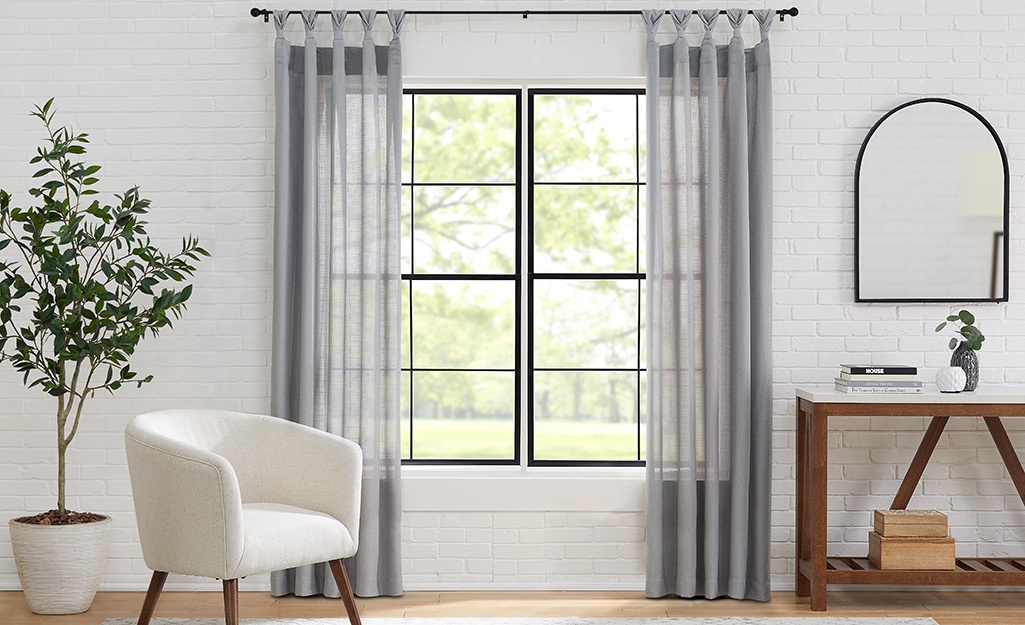Consider entering a living room that emanates warmth, elegance, and charm. You may ascribe this enticing atmosphere to the furniture, décor, or lighting, but have you ever considered the transformational effect of curtains?
The length and breadth of curtains, which are sometimes disregarded, have an important part in establishing the overall ambience of the living room. Understanding the influence of specific curtain dimensions is critical in attaining the appropriate combination of aesthetics and comfort, from generating a sense of height and grandeur to injecting a comfortable and private atmosphere.

The Importance of Curtains in Home Décor
Curtain length has a surprising power to change the apparent height of a space. Floor-to-ceiling draperies, for example, provide the appearance of grandeur and verticality, making even the smallest of spaces feel spacious and sumptuous.
Understanding how curtain length affects visual proportions accentuates architectural details and creates a harmonic balance between the room’s height and width.
Similarly, the width of the curtains affects the overall ambience and usefulness of the living space. When drawn back, wide drapes provide a sense of openness and enable plenty of natural light to permeate the area, providing an airy and large effect.
More fitted and thinner curtains, on the other hand, give privacy and a sense of cosiness, especially when matched with heavier textiles that help improve insulation and minimise outside noise. Homeowners may control the amount of light, privacy, and intimacy in their living areas by carefully selecting curtain width.
Curtain length and width interaction is a delicate skill that involves a sophisticated awareness of the room’s proportions, design style, and intended mood. This sophisticated dance allows homeowners to unlock the full potential of curtains, converting their living spaces into personal sanctuaries that reflect their own likes and preferences.
Factors Affecting Curtain Length and Width
When considering the appropriate curtain length and width for a living room, several factors come into play. Understanding these factors will help you make informed decisions that align with your desired ambience and overall design aesthetic. Here are some key factors to consider:
Room Height
The height of the room is important in deciding curtain length. Floor-to-ceiling drapes may add a feeling of grandeur and elegance to a room with high ceilings. Curtains that break somewhat at the floor or simply skim the floor might give a more balanced and proportionate impression in rooms with lower ceilings.
Window Size and Placement
The size and placement of windows influence the curtain length and width. For smaller windows, extending the curtains beyond the frame can create an illusion of larger windows and make the room appear more spacious. Conversely, larger windows may require wider curtains to effectively cover the window when closed.
Decor Style
The curtain measurements are influenced by the living room’s decor style. Contemporary curtains are frequently sleek and fitted with exact lengths and widths, whilst more classic or romantic versions may contain floor-length curtains with increased fullness and width for a more luxurious and dramatic impact.
Natural Light and Privacy
Consider how much natural light you want in the space and how much seclusion you want. Sheer or lightweight drapes provide more light while giving little seclusion. Thicker or blackout curtains, on the other hand, provide more light control and seclusion, particularly in bedrooms or areas facing busy streets.
Fabric and Texture
The kind of cloth and its intrinsic properties influence how curtains drape and gather. Lighter textiles, such as linen or silk, provide an airy and breezy atmosphere, whilst heavier fabrics, such as velvet or brocade, add refinement and grandeur. Different fabric weights will also influence how curtains hang and how wide they are when drawn open or closed.
Functional Considerations
It’s important to consider the functional aspects of curtains, such as their ability to insulate against heat or cold, reduce noise levels, or block out sunlight for better sleep. These factors may influence the choice of fabric thickness, lining options, and curtain width to ensure the desired functionality.
Personal Preference
Finally, curtain length and width are heavily influenced by personal desire. Some people like a more professional, tailored design with precise dimensions, whilst others prefer a more relaxed, informal image with drapes that puddle on the floor. It is critical to reflect your particular taste and create an environment that fits your lifestyle.
Understanding the parameters that determine curtain length and width empowers homeowners and interior lovers to make informed decisions that match their desired ambience. The room’s height, window size and placement, and décor style all contribute to the choice of curtain measurements that improve the overall design story.
Furthermore, the right curtain length and breadth must strike a balance between natural light, privacy, and usefulness. Personal preferences, as well as the kind of fabric and its intrinsic qualities, lead the decision-making process, allowing individuals to reflect their own tastes and lifestyle via their curtain selections.
So, whether you prefer the classic beauty of long, flowing curtains, or the modern attractiveness of sleek, fitted drapes, or other curtain ideas for living rooms, let your imagination run wild as you go on the voyage of creating the ideal atmosphere for your living room. Accept the transformational power of curtain dimensions and watch as your living area transforms into a real expression of your distinct vision, as well as a haven of comfort, beauty, and peace.
